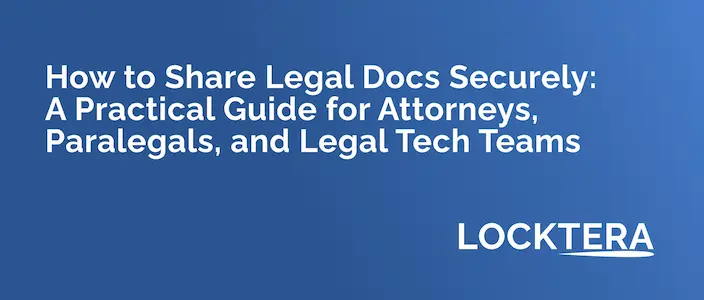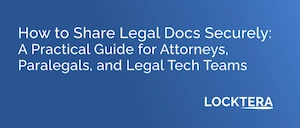Article
How to Share Legal Docs Securely:


Read time: 3:00
Published August 6, 2025
How to Share Legal Docs Securely: A Practical Guide for Attorneys, Paralegals, and Legal Tech Teams
In today’s fast-paced legal landscape, firms and clients exchange sensitive information daily — contracts, NDAs, litigation materials, estate documents, and more. But with rising cybersecurity threats and compliance demands (think GDPR, HIPAA, CJIS, or ABA Model Rules), it’s no longer enough to just “email a PDF.”
So, how can legal professionals share legal documents securely — without slowing down workflows or confusing clients?
Below is a breakdown of best practices, common pitfalls, and the security technologies that can help you protect confidential legal communications.
-
Understand What “Secure Sharing” Actually Means
Before choosing tools or workflows, define the security outcomes you need. Secure document sharing should include:
- End-to-end encryption (E2EE): Only the sender and receiver can access the file’s contents.
- Access control: Only specific people can open or download the document.
- Audit trails: Logs of who accessed what, and when.
- Expiration and revocation: The ability to time-limit access or revoke a document after it’s been shared.
Not all file-sharing platforms meet these standards — especially common email attachments or generic cloud storage links.
-
Avoid Email Attachments Whenever Possible
Email was never built for secure file transfers. Even with TLS encryption between servers, email attachments can:
- Be forwarded without restriction
- Live indefinitely in inboxes
- Be intercepted if users aren’t using secure devices or accounts
Instead, opt for file-sharing links with restricted access (see below).
-
Use Purpose-Built Legal File-Sharing Tools
Not all cloud platforms are created equal. Look for tools that offer:
| Feature | |
| File-level encryption | ✅ |
| Role-based access control | ✅ |
| Audit trails | ✅ |
| Revocation after sharing | ✅ |
| ABA / CJIS / GDPR compliance | ✅ |
If you’re in litigation, regulated industries, or handling high-profile matters, consider platforms that encrypt at the file level and offer zero-knowledge architecture — where even the hosting provider can’t read your data.
-
Set Expiration Dates, Passwords, and View Limits
Even with secure platforms, how you configure your sharing matters. Always:
- Set expiration dates on access links
- Use passwords or 2FA to verify recipients
- Restrict downloading if read-only access is enough
- Avoid sharing open links on email or chat apps — use invite-only access
If your platform doesn’t support these controls, it’s time to upgrade.
-
Don’t Forget Client Experience
Security should never create friction for clients. Choose platforms that:
- Don’t require complex signups
- Work on mobile and desktop
- Send alerts when documents are viewed or downloaded
- Let you revoke access instantly if needed
Think of it like this: if you wouldn’t feel comfortable sending a scanned will or M&A term sheet through the platform, don’t expect your clients to trust it either.
-
Bonus Tips for Legal Teams
- Train staff regularly on phishing, secure upload behavior, and data policies
- Keep local devices encrypted in case of loss or theft
- Always review audit logs on sensitive matters
- Never mix personal and professional devices for legal file sharing
Security is not a one-time setup — it’s a continuous process.
Wrapping Up
Sharing legal documents securely is more than a compliance checkbox — it’s about trust, ethics, and professionalism. By using the right tools and setting clear access policies, your firm can streamline workflows without compromising client confidentiality.
